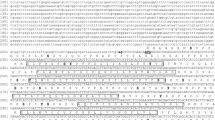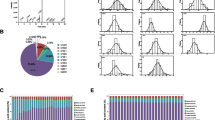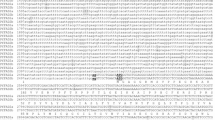Abstract
Safflower varieties were commonly divided into high, low and middle linoleic acid (LA) types according to their LA relative percentage contents in the seed oil. Fatty acid desaturase 2 (FAD2) plays a key role for LA content in seed. The sequence variations of FAD2 (CtFAD2-2, CtFAD2-10, CtFAD2-11) genes which could express in developmental seed of safflower were analyzed in 15 different LA-type materials. The results revealed that the CtFAD2-2 sequences were the same in all materials, and the CtFAD2-10, CtFAD2-11 sequences formed into two haplotypes independent of the LA-type of safflower seed. Yeast expression analysis revealed that two haplotypes of CtFAD2-10 had the function of oleic acid desaturase. The real-time PCR analysis of FAD2 in high and low LA-type materials at different seed developmental stages revealed that CtFAD2-2, CtFAD2-10 and CtFAD2-11 expressed mainly at 10 days after flower (DAF) for two different LA-type materials and the accumulation of few mRNA was detected in 14–22 DAF. The expression pattern of CtFAD2-1 in two different LA-type safflower materials was significantly divergent. For high-LA type, the accumulation of CtFAD2-1 mRNA was extremely low in 10 DAF, and its expression level increased sharply between 14 and 18 DAF and decreased slightly after 18 DAF. For low-LA type, the accumulation of CtFAD2-1 mRNA was extremely low during seed development stages. In conclusion, the gene structure and expression level of CtFAD2-1 may be the main factor affecting the differentiation of LA-type for safflower materials.



Similar content being viewed by others
References
Berberich T, Harada M, Sugawara K et al (1998) Two maize genes encoding omega-3 fatty acid desaturase and their differential expression to temperature. Plant Mol Biol 36(2):297–306
Browse J, Somerville C (1991) Glycerolipid synthesis: biochemistry and regulation. Annu Rev Plant Physiol Plant Mol Biol 42:456–506
Browse J, Xin Z (2001) Temperature sensing and cold acclimation. Curr Opin Plant Biol 4:241–246
Cao SJ, Zhou XR, Wood CC, Green AG, Singh SP et al (2013) A large and functionally diverse family of FAD2 genes in safflower (Carthamus tinctorius L.). BMC Plant Biol 13:5
Guan LL (2011) Accumulation pattern and regulatory mechanisms of fatty acid in different safflower (Carthamus tinctorius L.) tissues. Dissertation, Sichuan Agriculture University
Guan LL, Wu W, Zheng YL (2008) Seed oil contents and fatty acid compositions of seed oil from different safflower accessions introduced into Yaan and the correlation analysis with the agronomic traits and photosynthetic parameters. Philipp Agric Sci 91(4):383–388
Guan LL, Xu YW, Wang YB et al (2012) Isolation and characterization of a temperature-regulated microsomal oleate desaturase gene (CtFAD2-1) from safflower (Carthamus tinctorius L.). Plant Mol Biol Rep 30(2):391–402
Herńndez ML, Padilla MN, Mancha M et al (2009) Expression analysis identifies FAD2-2 as the olive oleate desaturase gene mainly responsible for the linoleic acid content in virgin olive oil. J Agric Food Chem 57(14):6199–6206
He ZK, Zhou XP, Wang MY et al (2017) Cloning and functional identification of a fatty acid desaturase gene, HaFAD2-1, from oil sunflower. Jiangsu J Agr Sci 33(2):273–279
Jung S, Swift D, Sengoku E et al (2000) The high oleate trait in the cultivated peanut (Arachis hypogaea L.) isolation and characterization of two genes encoding microsomal oleoyl-PC desaturases. Mol Gen Gene 263(5):796–805
Li DJ (1993) Progress of safflower (Carthamus tinctorius L.) research and production in China. In: Third International Safflower Conference, Beijing, China, pp 35-46
Li DJ, Zhou MD, Ramanatha Rao V (1993) Characterization and evaluation of safflower germplasm. Beijing, China
Li D, Hu B, Wang Q et al (2015) Identification and evaluation of reference genes for accurate transcription normalization in safflower under different experimental conditions. PLoS One 10(10):e0140218
Liu F, Zhao YP, Wang X et al (2015) Isolation and functional characterization of seed-specific FAD2-1 promoter from cotton (Gossypium hirsutum L.). J Plant Biochem Biot 24(4):369–375
Okuley J, Lightner K, Feldmann N, Yadav E, Lark J, Browse J (1994) Arabidopsis FAD2 gene encodes the enzyme that is essential for polyunsaturated lipid synthesis. Plant Cell 6:147–158
Rapson S, Wu M, Okada S et al (2015) A case study on the genetic origin of the high oleic acid trait through FAD2-1 DNA sequence variation in safflower (Carthamus tinctorius L.). Front Plant Sci 6:691
Sangwallek J, Kaneko Y, Tsukamoto T et al (2014) Cloning and functional analysis of HpFAD2 and HpFAD3 genes encoding Δ12- and Δ15-fatty acid desaturases in Hansenula polymorpha. Gene 533(1):110–118
Schlueter JA, Vasylenko-Sanders IF, Deshpande S et al (2006) The FAD2 gene family of soybean: insights into the structural and functional divergence of a paleopolyploid genome. Plant Genome (A supplement to crop science) 47:S14–S26
Shanklin J, Whittle E, Fox BG (1994) Eight histidine residues are catalytically essential in a membrane-associated iron enzyme, stearoyl-CoA desaturase, and are conserved in alkane hydroxylase and xylene monooxygenase. Biochemistry 33(43):12787–12794
Tiwari N, Sachdev A, Kumar J et al (2004) Developmental expression of microsomal omega-6 desaturase gene (fad2-1) in soybean seeds. J Plant Biochem Biot 13(2):107–111
Wang Y, Zhang X, Zhao Y et al (2015) Insights into the novel members of the FAD2 gene family involved in high-oleate fluxes in peanut. Genome/Natl Res Council Can 58:1
Weber H (2002) Fatty acid -derived signals in plants. Trends Plant Sci 7:217–224
Xie Y, Wang X (2018) Comparative transcriptomic analysis identifies genes responsible for fruit count and oil yield in the oil tea plant Camellia chekiangoleosa. Sci Rep 8(1):6637
Zaplin ES, Liu Q, Li ZY et al (2013) Production of high oleic rice grains by suppressing the expression of the OsFAD2-1 gene. Func Plant Biol 40(10):996–1004
Zavallo D, Lopez BM, Esteban HH et al (2010) Isolation and functional characterization of two novel seed-specific promoters from sunflower (Helianthus annuus L.). Plant Cell Rep 29(3):239–248
Zhang DY, Pirtle IL, Park SJ et al (2009) Identification and expression of a new delta-12 fatty acid desaturase (FAD2-4) gene in upland cotton and its functional expression in yeast and Arabidopsis thaliana plants. Plant Physiol Biochem 47(6):462–471
Zhou F, Huang X, Liang C et al (2016) Molecular cloning and expression analysis of fatty acid dehydrogenase gene FAD2-1 in oil sunflower (Helianthus annuus L.). Heilongjiang Agri Sci (05):8–12
Acknowledgements
This work was financially supported by the National Natural Science Foundation of China (#81274020).
Author information
Authors and Affiliations
Corresponding author
Additional information
Communicated by P. Wojtaszek.
Publisher's Note
Springer Nature remains neutral with regard to jurisdictional claims in published maps and institutional affiliations.
Electronic supplementary material
Below is the link to the electronic supplementary material.
Rights and permissions
About this article
Cite this article
Li, D., Yu, J., Wang, Q. et al. Sequence variations and expression analysis of FAD2 gene among safflower materials with different linoleic acid content in seed oil. Acta Physiol Plant 41, 135 (2019). https://doi.org/10.1007/s11738-019-2928-4
Received:
Revised:
Accepted:
Published:
DOI: https://doi.org/10.1007/s11738-019-2928-4




